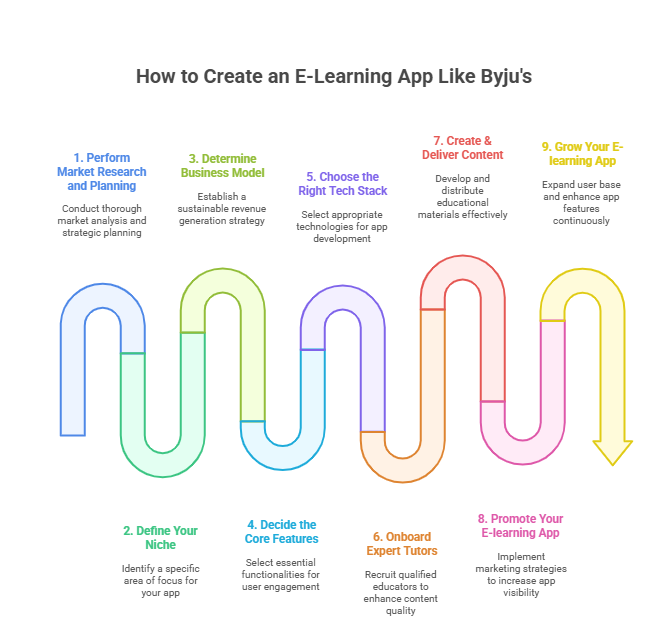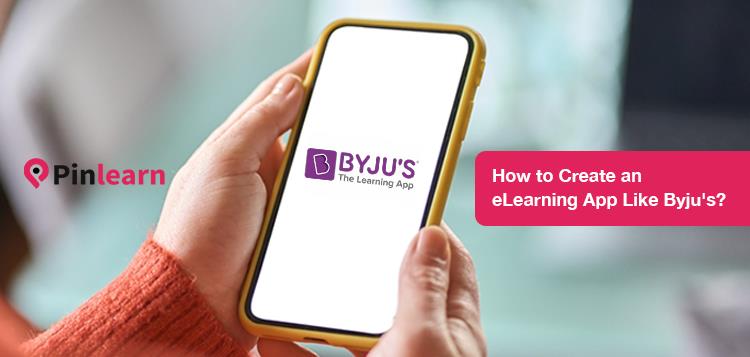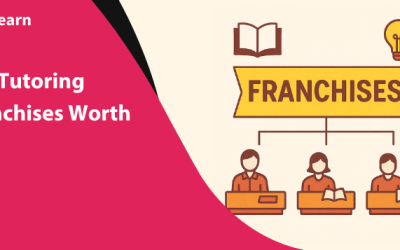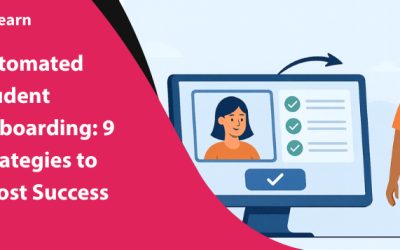How to Create an E-Learning App Like Byju’s?
Can you build a $22 valuation business by offering educational courses? Well, it’s possible and that’s how Byju’s defined an inspiring narrative in the industry!
With a strategic blend of video lessons and personalized learning path, Byju’s captured a massive market share early in the business. Even Harvard’s business school made an interesting case study on this once business tycoon.
If you’re building an educational business, you can learn a lot from Byju’s journey. From its impressive growth, business model, and eventual downfall, we’ll cover everything! In this post, we’ll answer — how to create an e-learning app like Byju’s!
So, let’s take a closer look at Byju’s astounding success and learn some golden nuggets of wisdom!
Step-by-Step Guide on How to Create an E-Learning App Like Byju’s
Here’s a detailed roadmap on creating an e-learning app like Byju:

Step 1: Perform Market Research and Planning
First off, perform comprehensive research before building the e-learning app. Find more about your market and audience.
Follow these steps to perform market research:
-
Define Your Target Audience
Are your learners students, professionals, or high-school students? Find their needs and preferences. Look at their demographics (interests, gender, age, location), preferences and pain points.
-
Analyse Your Competitors
Identify your key competitors who have climbed the success ladder. For example, Vedantu, Khan Academy, Coursera, and Byju’s are competitors. Uncover their core business model, features, marketing strategies, prices, etc.
Thus, you can find their shortcomings and gain a competitive advantage.
-
Define your USP
E-learning is a competitive field with many players out there. You need a strong differentiation to get noticed. This could be teaching methodology, features, or even your business model.
For Byju’s, it was their interactive video lessons. Even motion graphics, voice-over narrations, and gamified visuals stole the show!
-
Gather Secondary Data
Get secondary data from diverse sources like focus groups, surveys, keyword research tools, forums, etc. These inputs could help you design a learner-centric platform.
Step 2: Define Your Niche
Now that you have gathered enough information about the market. It’s time to choose a profitable niche for your e-learning app. For this purpose, look at the current market trend and opportunities.
K-12, language learning, and professional exams are popular niches.
If you’re planning to build an e-learning app like Byju, don’t go for a generic niche.
So, how to find a niche? Your niche should tick these points: passion, strength, market demand.
Few profitable niche ideas for building an app like Byju’s are:
- Language learning app for K-12
- Exam-preparation app for SAT, AWS, GRE, IIT, etc
- Video-based learning for STEM (like Byju)
- App personalized for special needs students like ADHD, autism, dyslexia
- Live tutoring like Vedantu for K-12
Narrow down further to a specific segment of audience. For example, targeting down to a specific region or age-group.
Tip: Before settling on a niche, ensure it is profitable yet underserved. This ensures your app can withstand the competition. Also, ensure your USP has a solid emotional or financial motivation.
Step 3: Determine Business Model
Before its downfall, Byju earned an impressive $200 billion in revenue in 2019.
So, what led to this astounding success?
A remarkable business model.
Byju adopted a freemium cum subscription model. It offered free content like online video lessons and interactive exercises to attract its initial customers.
Once learners get glued to the content, they can unlock the premium features. These include video lesson libraries, mini-games, personalized learning paths, etc. So, the main revenue came from monthly and yearly subscriptions.
Byju’s adopted a hybrid approach combining both online and offline classes. Further, the app adopted the two-teacher model. One tutor led the online classes, while the other tutor offered personalized support in sessions.
Primary Revenue Streams
- Subscriptions (monthly and annual subscriptions)
- B2B partnerships (schools and educational institutions)
- Test preparation materials (JEE, NEET, UPSC)
- International expansion ( Acquiring companies like Osmos, Epic)
Additional Revenue Models:
- Pay-per-course
- One-time payment courses
- Affiliate courses
- Live tutoring
- In-app purchases
Byju’s focused on one problem and helped business expansion. For instance, initially the app delivered video lessons through V-SAT to over 45 cities. Later, he got over 1200 online coaching requests and eventually Byju’s happened.
Step 4: Decide the Core Features
So, let’s sum up the story so far! You have found your niche, completed market research, and business model.
This is one of the essential steps in this “how to create an e-learning app like Byju’s guide.”
A well-thought-out design lays the ground for a successful e-learning app.
Focus on building a user-friendly app with seamless content delivery. While delivering core lessons, infuse engagement and feedback loops. This way, you ensure a unified learning experience!
Below are the core MVP features:
Student Features
- Interactive Video Lessons
- Personalized Learning Journeys
- Doubt-resolution Sessions
- Live classes with Experts
- Polls and chats during classes
- Virtual Whiteboards
- Competitive exams
- Quizzes and Exercises
- Gamified learning like streaks, badges, leaderboards
- Multi-language support
- Personalized learning paths
- Multi-platform Support
- Daily Reminders & Notifications
Educator Features
- Scheduling Sessions
- Data Analytics
- Student-engagement dashboards
Parent Features
- Weekly Progress Reports
- Push notifications
- SMS Alerts on class schedules
- Communication dashboard
Admin Features
- Learner Management
- Instructor Management
- Session Management
- Manage Subscription and Payments
- Student Progress Analytics
- Content Management
💡 Tip: Do you wish to ace the e-learning game? Apart from the core features, look for unique features like AR/VR, AI tutor, adaptive learning paths, etc.
Step 5: Choose the Right Tech Stack
Byju’s e-learning delivers content with personalization and engagement. Creating such a scalable and robust app needs a robust tech stack.
Below is the complete tech stack for building an e-learning app like Byju’s:
| Development Aspect | Tech Stack |
| Front-End Development | React Native/Flutter, Kotlin/Java, Swift |
| Back-End Development | Node.js and Python/Django |
| Database | MongoDB, PostgreSQL, MySQL |
| Video Hosting | Vimeo API, YouTube API |
| Live Class | Zoom SDK, Agora |
| Analytics | Firebase, MixPanel, Amplitude |
| Mobile Development | React Native and Flutter |
| DevOps and Deployment | Jenkins, Docker, Kubernotes, |
| Cloud Development | Amazon Web Services (AWS) |
| Security | OuAuth, JWT (Authentication), Encryption |
Don’t have the technical expertise to build an e-learning app? Leverage a trusted Byju’s clone app like Pinlearn. No design or coding skills required. Build an app like Byju’s with essential features and beyond!
From video hosting to self-paced courses, and gamification mechanics, Pinlearn is your complete e-learning solution!
Step 6: Onboard Expert Tutors
You might have designed an e-learning app with the best features and technology. But, without hiring the right educators, you can’t be successful!
Create a clear job description based on your requirements. Mention the qualifications, subject matter expertise, and experience you require. Look for tutors with previous teaching and tutoring experience.
For instance, if you’re looking for a Math tutor. Clearly mention the grade like you’re looking for someone for grade 4-10 with a bachelor’s/ master’s degree in Maths. Also, mention the curriculum and familiarity with taking online audio/video lessons. Familiarity with concepts like algebra, calculus, or statistics.
Create a streamlined hiring process: initial assessment, interview and selection, background-check, and onboarding.
Above all, a fair and professional hiring process matters. After onboarding, aim for sustainable growth of your educators. This could be through seminars, certifications, mentorship programs.
⚡ Related: How to Attract Top Tutors to Your Platform?
Step 7: Create & Deliver Content
High-quality content is the cornerstone for a successful e-learning app like Byju’s. When you deliver value to learners, they stick to your e-learning app for long!
Collaborate with subject-matter experts to create engaging content. Educators, content creators, and learning partners have niche expertise. Either outsource content to them or involve them in the process.
While curating content, prioritize learners’ needs and expectations. Categorize your content and create lessons for easy access.
Here are a few techniques from Byju’s playbook:
-
Real-World Context
Explain concepts with practical scenarios or real-life examples. This enhances retention and makes grasping concepts easier.
-
Visual Storytelling
Use visual aids and graphics for abstract concepts. It improves memory retention, comprehension, and critical thinking skills. This way, learning turns into a joyful and engaging experience!
-
Problem-Solution Scenarios
Presenting the content as problem-solution scenarios is a powerful learning method. Students learn to identify, analyze and apply concepts for actual scenarios..
-
Interactivity
Integrate quizzes, assignments, and discussion forums to make learning engaging. For instance, scenarios like “choose your own adventure” exercises. Here, learners can make decisions and find outcomes.
-
Character-Development
How do you pull in learners’ attention while explaining a concept? Try explaining with relatable personas and characters. Design a compelling story, narrative, or scenario revolving around your course content. Then, you can introduce the character in that scene.
Step 8: Promote Your E-learning App
Now that you have onboarded tutors and created a solid curriculum. It’s time to move on to actual user acquisition!
Learners won’t know about your app without spreading the word! Go ahead and promote it with a “feet-on-street” approach. That’s exactly what Byju did!
Ace the 4 P’s of marketing – price, product, promotion & placement.
Like Byju discovered, their actual target audience were parents and not students. Henceforth, all their marketing campaigns were in that direction!
Here’s a mix of marketing strategies you can adopt:
-
Social Media Marketing
Every social media gives you a unique set of audience. So, find the potential social platforms where parents and students hang out.
For instance, you could post engaging success stories, learning hacks, and explainer videos on Facebook. At the same time, you could post long-form educational videos on YouTube. This could be a learning hub and build trust around your brand.
-
Collaborations & Sponsorships
Among other marketing strategies, Byju is well-known for sponsorships. Who can forget Byju’s iconic SRK commercial? Byju has also leveraged people’s love for cinema and cricket in its sponsorships. In ICC World Cup 2021, Byju was the global partner, maximizing brand exposure.
-
App Store Optimization
While launching your app on the store, ensure you create an optimized app listing. Include relevant keywords in app title, descriptions, screenshots, etc. This way, you appear for relevant search results.
-
Paid Advertising
Advertise on Google Ads, Apple Search Ads, Meta Ads to maximize your reach. Fine-tune ads to nuanced details like age, location, interests, etc. Run re-targeting ads based on those who have already shown interest earlier.
-
Free Content Access
Offer free content to build your initial audience. This includes video lessons, practice tests, and other learning materials.
-
Referral Programs
Your existing users are your best brand advocates! Create an attractive referral system with discounts on courses, free content access, or premium features. Make it easy to share referral links on emails, social media, messages, etc.
-
Email Marketing Campaigns
E-mail campaigns still hold an amazing potential given their personalization and segmentation. Start with welcome and onboarding mails. Move on to course or program launches, educational emails or newsletters. Launch promotional offers and attractive discounts through the mail.
Step 9: Grow Your E-learning App
You have built your e-learning app and acquired your initial userbase. But, you can’t just stop there! Scaling your e-learning app is also an essential part of your development process.
As learners’ needs constantly evolve, embracing adequate growth strategies is crucial.
After all, you don’t want to hit the stagnancy phase, right?
User feedback is crucial to expand your learning business. Monitor for KPIs like overall users, churn rates, session duration, etc. Gather the data-driven insights to devise an effective growth plan.
Key Growth Strategies:
- Offer your educational offerings across different regions, languages, and cultures
- Diversify with self-paced courses, live tutoring, B2B partnerships
- Partnering with local schools, colleges, and institutions
- Scale with technology like cloud and AI personalization.
- Regular content updates for courses, micro-learning, personalized learning paths
Well, that’s a wrap! We have covered everything about how to create an e-learning app like Byju’s.
Moving Beyond Byju’s App: Overcoming Challenges & Failures
Byju’s journey started as an offline tutoring app, but soon transitioned into the online sector.
With its surreal growth trajectory, Byju earned a massive customer base of 100 million students. Credit it to strategic collaborations, a staunch business model, or clever acquisition strategies. Byju played it well!
But, despite its fast-evolving business, Byju’s growth saw a downturn.
Here are a few lessons learnt from Byju’s failure:
-
Managing Customer Acquisition Cost Effectively
Byju’s aggressive marketing strategy and sponsorships amounted to major losses. Despite its massive user base, it couldn’t earn much profit.
When you spend more on customer acquisition, it might cost more than incoming revenue.
-
Regulatory and Legal Issues
In 2022, Byju’s faced a hefty $10 million penalty by the Indian government. The unreal promises by its educational programs led to such losses. So, ensure your e-learning business is legally compliant. Also, copyright your platform content to avoid any infringement risk.
-
Financial Struggles
Byju’s incurred a $200 million loss due to its towering operating, marketing, and content costs. So, what’s the moral: Make calculative risks and keep an eye on your development cost.
-
Tackling Quality Control and Customer Satisfaction
Meanwhile, its lesson quality declined and customers were dissatisfied. This raised the customer queries and led to slew of negative reviews. The important lesson here is to value retention more than user acquisition.
Final Thoughts
Creating a ground-breaking app like Byju sure is a profitable pursuit. Byju evolved as an edtech giant with its robust business model and expansion strategies.
Creating an e-learning app like Byju’s needs a clear strategy and action plan. From initial market research to essential features and marketing strategy, you need an inventive mindset.
Pinlearn is a trusted e-learning solution provider with industry experience to guide you from ideation to launch. Ready to scale your EdTech dream into reality?
FAQ-Related to How to Create an E-Learning App Like Byju’s
1. How to create an e-learning app like Byju’s?
To build an e-learning app like Byju’s, follow these steps:
- Identify USP to build your e-learning app
- Conduct market research
- Determine the right business model
- Decide the core features for your app
- Choose the right development approach
- Onboard expert tutors onto your e-learning app
- Create & deliver your content
- Market your e-learning app
- Grow your e-learning app
2. What is the cost of Byju’s app?
The overall cost to create an e-learning app like Byju’s is around $40,000 to $70,000. It varies based on app complexity, developer cost, and other customizations.
3. Which are the biggest competitors of Byju’s app?
Vedantu, Upgrad,Unacademy, and Khan Academy, are platforms similar to Byju’s. They offer services like live tutoring, video lessons, and test preparation materials.
4. Why did Byju’s shut down?
After its impressive success, Byju’s business went downhill due to:
- High customer acquisition cost
- Regulatory and legal issues
- Financial struggles
- Low content quality and customer dissatisfaction
- Customer retention issues





